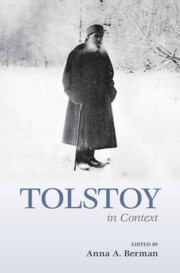Book contents
- Tolstoy in Context
- Tolstoy in Context
- Copyright page
- Contents
- Figures
- Notes on Contributors
- Preface
- Acknowledgments
- Note on Citations, Translations, and Transliterations
- Chronology
- Part I The Man
- Part II Russian Social and Political Contexts
- Part III Literature, the Arts, and Intellectual Life
- Part IV Science and Technology
- Part V Beyond Russia
- Part VI Tolstoy’s Afterlife
- Chapter 34 Tolstoy’s Complete Works
- Chapter 35 Tolstoy in English Translation
- Chapter 36 Film Adaptations
- Chapter 37 Musical Adaptations
- Chapter 38 Biographies
- Chapter 39 Tolstoy as the Subject of Art: Painting, Film, Theater
- Suggested Further Reading
- Index
Chapter 37 - Musical Adaptations
from Part VI - Tolstoy’s Afterlife
Published online by Cambridge University Press: 05 January 2023
- Tolstoy in Context
- Tolstoy in Context
- Copyright page
- Contents
- Figures
- Notes on Contributors
- Preface
- Acknowledgments
- Note on Citations, Translations, and Transliterations
- Chronology
- Part I The Man
- Part II Russian Social and Political Contexts
- Part III Literature, the Arts, and Intellectual Life
- Part IV Science and Technology
- Part V Beyond Russia
- Part VI Tolstoy’s Afterlife
- Chapter 34 Tolstoy’s Complete Works
- Chapter 35 Tolstoy in English Translation
- Chapter 36 Film Adaptations
- Chapter 37 Musical Adaptations
- Chapter 38 Biographies
- Chapter 39 Tolstoy as the Subject of Art: Painting, Film, Theater
- Suggested Further Reading
- Index
Summary
While Tolstoy is best known as a novelist, many become acquainted with his works through musical adaptations. These multinational adaptations span different genres and vary in their degrees of fame, sophistication, and resemblance to the original. This chapter adopts the analogy of a theme and variations to consider the symbiotic relationship between source texts and adaptations. The characteristics unique to literature vis-à-vis music are also discussed to illustrate the advantages and challenges of setting literature, in particular prose, to music. The chapter examines works in each genre with musical analyses and offers genre-specific commentary. In addition to instrumental music, ballet, and opera, musicals are included because they bridge high art and more popular genres and have been instrumental in revitalizing many classics of Russian literature. The chapter concludes with a discussion of operatic adaptations, using Prokofiev’s War and Peace as an example. The opera illustrates many challenges typical of setting sprawling prose texts to music of various genres, such as reducing the number of scenes and characters as well as reimagining the text. The appendix includes a list of adaptations; as many works on the list are not well known, they may be further examined by scholars.
Keywords
- Type
- Chapter
- Information
- Tolstoy in Context , pp. 305 - 314Publisher: Cambridge University PressPrint publication year: 2022

